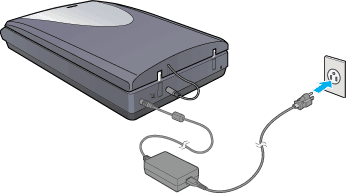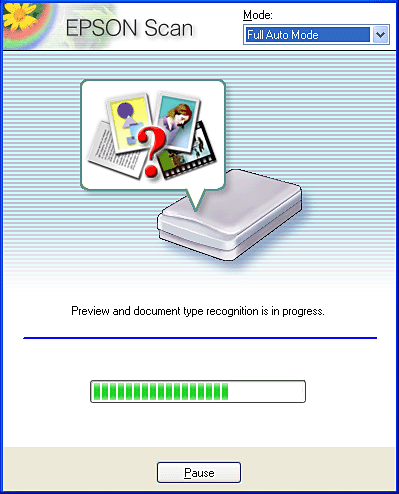|

Reference Guide
|
|
Basics Scanning Procedure
Scanning an Image
 Step 1. Turning on the scanner
Step 1. Turning on the scanner
 Step 2. Placing your materials on the document table
Step 2. Placing your materials on the document table
 Step 3. Starting the software and scanning an image
Step 3. Starting the software and scanning an image
EPSON Scan provides three modes for you to make any scanning settings: Full Auto Mode, Home Mode, and Professional Mode. This section describes how to scan an image in the Full Auto Mode. The Full Auto Mode lets you scan images using automatically-adjusted settings. For more details, see Choose the Appropriate Scanning Mode.
 |
Note:
|
 | -
You cannot scan an image with a size that exceeds the available memory or disk space. If you try to scan the image, an alert appears on the screen.
|
|
 | -
Most illustrations shown in this section are for the Perfection 2480 Photo, so they may be different in appearance from the Perfection 2580 Photo. The instructions are the same, except as noted.
|
|
 |
Note for Macintosh users:
|
 | |
Most illustrations shown in this section are for Windows, so they may vary in appearance from what actually appears on your screen. The instructions are the same, except as noted.
|
|
 |
Caution:
|
 | |
Before starting the following steps, make sure that all the necessary software including EPSON Scan has been installed. For details about how to install the software, see the Start Here poster.
|
|
Step 1. Turning on the scanner
 |
Before turning on the scanner, make sure the transportation lock is turned to the unlocked position.
|
The transportation lock is located on the bottom of the scanner on the right side. To release the lock, lift the scanner straight up and then slide the lock to the unlocked position.
 |  |
Caution:
|
 |  | |
Do not turn the scanner over; this may damage the scanner.
|
|

 |
Connect the cover cable.
|

 |
Turn on the scanner by plugging in the power cord. The  Start button light blinks, and then stays on in green, meaning the scanner has completed its initialization. Start button light blinks, and then stays on in green, meaning the scanner has completed its initialization.
|

 |  |
Note:
|
 |  | |
In any case, if the cover cable is already plugged into the scanner, do not disconnect the cover cable once after you turn on the scanner.
|
|
 |
Use the USB cable that comes with your scanner. Plug the square end of the USB cable into the scanner's USB port and then plug the flat end into any available USB port on your computer.
|

 |  |
Note:
|
 |  | |
Your scanner may not work correctly if you use a USB cable other than the one supplied by Epson, or if you connect your scanner through more than one hub system.
|
|
 |  |
Caution:
|
 |  | |
The interface cable connectors have only one correct orientation. Ensure the correct orientation of a connector before inserting it into the appropriate port.
|
|

[Top]
Step 2. Placing your materials on the document table
You can scan two types of materials: transparent materials (like film) or reflective documents (like photo or paper). See the appropriate link below to set your materials on the document table.

[Top]
Step 3. Starting the software and scanning an image
 |
Note for Mac OS X users:
|
 | |
Depending on your application, you may not be able to start EPSON Scan as described here.
|
|
You can start EPSON Scan in the following ways.
-
Start EPSON Scan directly as a stand alone application
For detail, see Start Scanner Software (EPSON Scan) Directly.
-
Start EPSON Scan from a TWAIN-compliant application
For detail to start from the EPSON Smart Panel, see Overview of EPSON Smart Panel.
This section describes how to start EPSON Scan from ArcSoft PhotoImpression.
 |
Note for Mac OS X 10.3 users:
|
 | |
Do not use the Fast User Switching function while using the scanner.
|
|
 |
Start ArcSoft PhotoImpression.
|
Double click the PhotoImpression 5 (PhotoImpression for Macintosh users) icon on your desktop.
You can also start the ArcSoft PhotoImpression in the way below.
For Windows users:
Click Start, point to All Programs (for Windows XP users) or Programs (for Windows Me, 98 SE, or 2000 users), and then select ArcSoft PhotoImpression 5. Finally, click PhotoImpression 5.
For Macintosh users:
Double-click the Applications folder in Macintosh HD, and then double-click the ArcSoft PhotoImpression 5 folder. Finally, double-click the PhotoImpression.
 |
Click the Get Photo button and then click the Camera/Scanner button on the main screen.
|
 |
In the Save my acquired photos section of the right side of the main screen, select a file format from the File Format list. See File formats lists for more details.
|
Specify a location. If you want to change the default location, click the Browse icon and then select a desired folder.
 |
Click the EPSON Perfection 2480/2580 button.
|
 |  |
Note for Windows XP users:
|
 |  | |
Do not choose WIA-EPSON Perfection 2480/2580 from the menu to select the scanner. If you select it, you cannot use the Epson scanner function fully.
|
|
 |
EPSON Scan automatically previews the image, and recognizes the document source and type.
|

If you want to make more settings, click Pause and then click Options to open the Options dialog box. For more details on settings, see the online help by clicking the Help button in the Option dialog box.
 |
After EPSON Scan has previewed and recognized the document type, the following window appears. You can see the previewed image in the window.
|

EPSON Scan automatically locates the target images and modifies their skew, and then starts scanning.
 |  |
Note:
|
 |  | |
Be aware that clicking Cancel on this screen terminates EPSON Scan.
|
|
 |
The scanned image is sent to ArcSoft PhotoImpression and saved to the specified folder.
|
 |
Note:
|
 | -
Depending on the image you want to scan, you may not get the expected scanned image. In this case, scan the image in the Home Mode or the Professional Mode.
|
|
 | -
For information on further editing of the scanned images, refer to your application's documentation.
|
|
File formats lists
The following table lists image file formats available in ArcSoft PhotoImpression. Select an appropriate file format before scanning images.
|
Format (File extension)
|
Explanation
|
|
BITMAP (*.BMP)
|
A standard image file format for Windows. Most Windows applications including word processing applications can read and prepare images in this format.
|
|
JPEG (*.JPG)
|
A compressed file format. The compression quality can be selected. The JPEG format enables relatively high compression ratio. However, the higher the compression ratio is, the lower the image quality becomes. (Note that the original data cannot be restored.) In addition, the quality deteriorates every time the data is saved. The TIFF format is recommended in cases where modification, retouch and the like are required.
|
|
PNG format (*.PNG)
(for Windows only)
|
PNG is a portable and highly-compressed file format designed for viewing in Web browsing applications, which allows a choice in compression quality. The image quality does not deteriorate when the image file is saved in PNG.
|
|
TIFF (*.TIF)
|
A file format created for exchanging data among many applications, such as graphic and DTP software. When scanning black & white images, you can specify the compression type.
|

[Top]
| Version NPD0616-00, Copyright © 2004, SEIKO EPSON CORPORATION |
Step 1. Turning on the scanner
Step 2. Placing your materials on the document table
Step 3. Starting the software and scanning an image